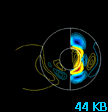


The lava catches Earth's magnetic field in the act of reversing itself. Magnetic north heads south, and -- over about 1,000 years -- the field does a complete flip-flop. While the Oregon data is controversial, Earth scientists agree that the geological evidence as a whole -- the "paleomagnetic" record -- proves such reversals happened many times over the past billion years.
"Some reversals occurred within a few 10,000 years of each other," says Los Alamos scientist Gary Glatzmaier, "and there are other periods where no reversals occurred for tens of millions of years." How do these flip-flops happen, and why at such irregular intervals? The geological data, invaluable to show what happened, registers only a mute shrug when it comes to the deeper questions.
For that matter, why is it that instead of quietly fading away, as magnetic fields do when left to their own devices, Earth's magnetic field is still going strong after billions of years? Einstein is said to have considered it one of the most important unsolved problems in physics. With a year of computing on Pittsburgh's CRAY C90, 2,000 hours of processing, Glatzmaier and collaborator Paul Roberts of UCLA took a big step toward some answers. Their numerical model of the electromagnetic, fluid dynamical processes of Earth's interior reproduced key features of the magnetic field over more than 40,000 years of simulated time. To top it off, the computer-generated field reversed itself.
"We weren't expecting it," says Roberts, "and were delighted. This gives us confidence we've built a credible bridge between theory and the paleomagnetic data." Their surprising results, reported as a cover story in Nature (Sept. 21, 1995), provide an inner-Earth view of geomagnetic phenomena that have not been observed or anticipated by theory. Furthermore, the Glatzmaier-Roberts model offers, for the first time, a coherent explanation of magnetic field reversal.
 |
By itself, the reversal is strong confirmation of the model, and other details -- magnitude and structure of the field -- also agree well with surface features of Earth's field. The simulation also offers precious insight into the dynamics that sustain the magnetic field and generate reversals. Contrary to what anyone guessed till now, the model shows that in the inner core the magnetic field has an opposite polarity from the outer core, and this stabilizes the field against a tendency to reverse more frequently.
"No one even dreamed about this," says Glatzmaier. "That's the nice thing about a supercomputer. You can just let it do its thing, solve these equations over and over -- a large set of variables affecting each other with nonlinear feedback, very hard to figure out. It's a beautiful problem for a supercomputer, and it's really exciting to see this structure and dynamics that no one imagined."
 |
 |
 |
Reversal of Earth's Magnetic Field
Earth's magnetic field evolving for about 9,000 years before, during and after the simulated reversal. The outer circle indicates the fluid outer core boundary; the inner circle, the solid inner core. The left hemisphere shows magnetic field contours directed clockwise (green) and counterclockwise (yellow). The right hemisphere shows contours directed westward (blue) and eastward (red), out of and into the plane of the paper.
The left hemisphere shows that the field penetrating the inner core is
opposed in polarity to the outer core, a feature completely unanticipated by
theory. "The outer core polarity," explains Glatzmaier, "is continually trying
to invade the inner core. Only when the whole field almost decays away, however
[middle], does it finally have a chance to diffuse in. Once it does, the
opposite polarity gets established. The inner core polarity is the stabilizing
force, like an anchor, the slowest thing that can change."
Animation
 |
Click on the image to the left to download the animation (1.62
MB).
![]()